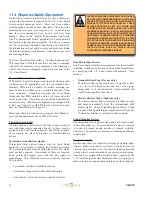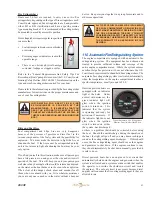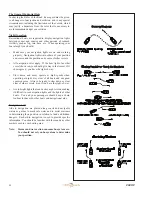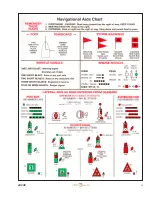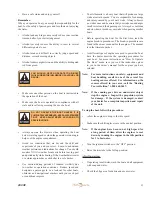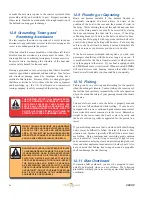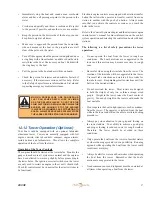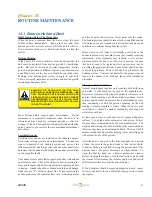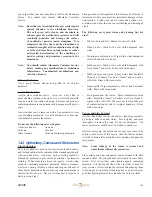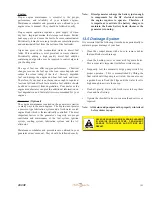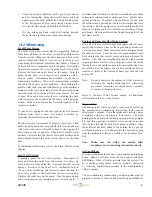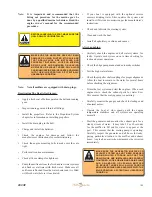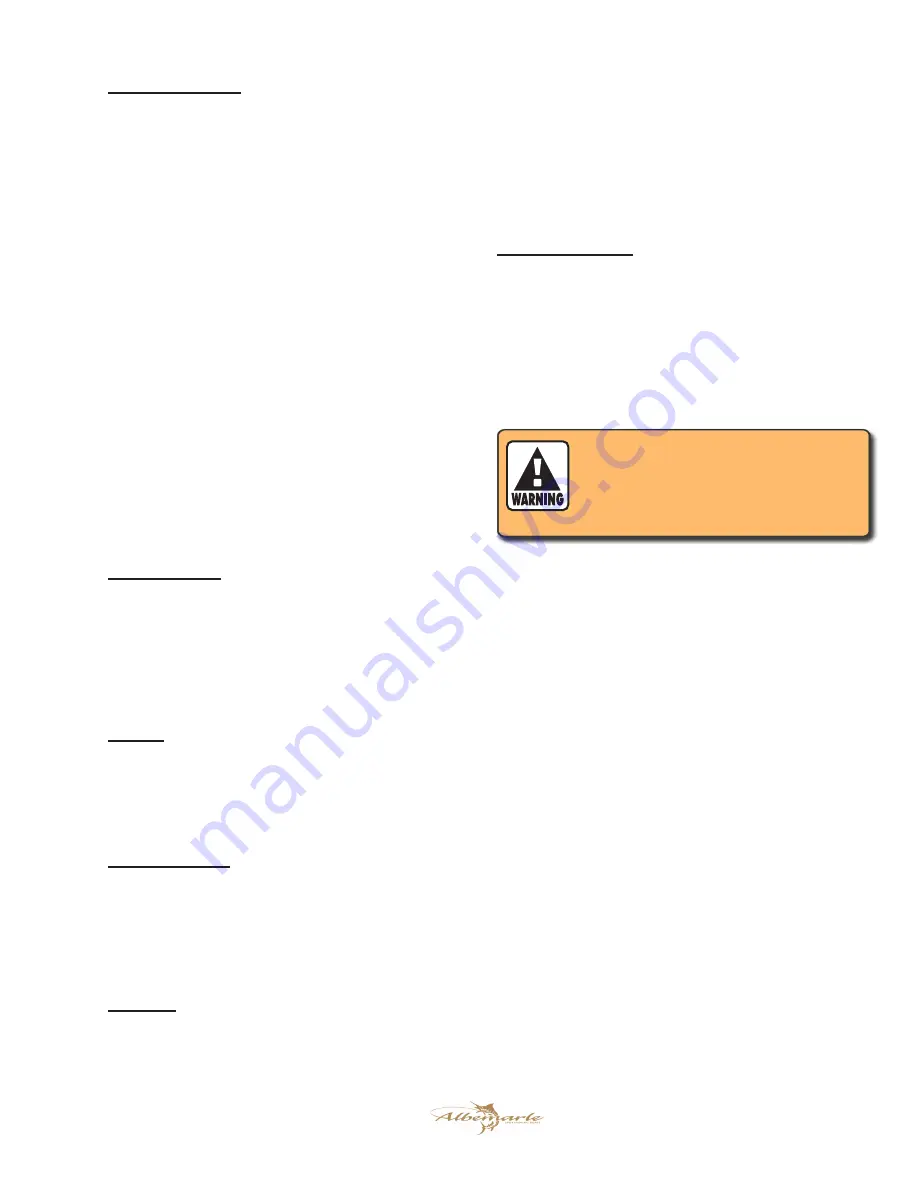
95
290 XF
Securing Dock Lines
Securing a boat that is tied along side the dock typically
requires a bow and stern line and two spring lines. The bow
and stern lines are usually secured to the dock at a 40° angle
aft of the stern cleat and forward of the bow cleat. The after
bow spring line is secured to the dock at a 40° angle aft of the
after bow spring cleat. The forward quarter spring is secured
to the dock at a 40° angle forward of the stern cleat. The
spring lines keep the boat square to the dock and reduce fore
and aft movement while allowing the boat to move up and
down with the tide.
Securing a boat that in a slip is somewhat different. It
typically requires two bow lines secured to pilings on each
side of the bow, two stern lines secured to the dock and two
spring lines that prevent the boat from hitting the dock. The
bow lines are typically secured with enough slack to allow
the boat to ride the tide. The stern lines are crossed. One line
runs from the port aft boat cleat to the starboard dock cleat
and the other line runs from the starboard aft boat cleat to the
port cleat on the dock. The stern lines center the boat, control
the forward motion, and allow the boat to ride the tide. Two
forward quarter spring lines typically are secured to the stern
cleats and to mid ship pilings or cleats. The spring lines keep
the boat from backing into the dock while allowing it to ride
the tide.
Leaving the Dock
Always start the engines and let them warm up for several
minutes before releasing the lines. Boats steer from the stern
and it is important that you achieve enough clearance at the
stern to maneuver the boat as quickly as possible. Push the
stern off and maneuver such that you get stern clearance
quickly. Proceed slowly until well clear of the dock and other
boats.
Mooring
Approach the mooring heading into the wind or current.
Shift to neutral when you have just enough headway to reach
the buoy. Position a crew member on the bow to retrieve
the mooring with a boat hook and secure the line. Keep the
engines running until the line is secured.
Leaving a Mooring
Start the engines and let them warm up for several minutes
before releasing the mooring line. The boat will already be
headed into the wind, so move it forward enough to loosen
the line and untie it. Back the boat away from the mooring
until you can see the buoy. Move the boat slowly away from
the mooring.
Anchoring
Make sure the bitter end of the anchor line is attached to boat
before dropping the anchor. Bring the bow into the wind or
current and put the engine in neutral. When the vessel comes
to a stop, lower the anchor over the bow. Pay out anchor
line so that it is at least 5 to 7 times the depth of the water
and secure the line to a cleat. Use caution to avoid getting
your feet or hands tangle in the line. Additional scope of 10
times the depth may be required for storm conditions. Check
landmarks on shore to make sure the anchor is not dragging.
If it is dragging, you will have to start all over. It is prudent to
use two anchors if your are anchoring overnight or in rough
weather.
Releasing the Anchor
Release the anchor by driving the boat slowly to the point
where the anchor line becomes vertical. It should release
when you pass that point. If the anchor doesn’t release right
away, stop the boat directly above the anchor and tie the line
to the cleat as tight as possible. The up and down movement
of the boat will usually loosen the anchor within a minute.
Make sure you secure the anchor and properly stow the line
before operating the boat.
NEVER ANCHOR THE bOAT bY THE STERN.
THE STERN OF THE bOAT IS VULNERAbLE TO
SWAMPING FROM WAVE ACTION AND WIND AND
CURRENT WILL PUT MORE STRESS ON THE
ANCHOR WHEN IT IS ATTACHED TO THE STERN.
ONLY ANCHOR THE bOAT bY THE bOW
12.6 Controls, Steering, or
Propulsion System Failure:
If the propulsion, control or steering system fails while you
are operating the boat, bring both throttles to idle and shift
to neutral. Decide whether you need to put out the anchor
to prevent the boat from drifting or to hold the bow into the
seas. Investigate and correct the problem if you can. Turn
the engines off before going into the engine compartment to
make repairs. If you are unable to correct the problem, call
for help.
If only one engine has failed, you can usually run home on
the other engine. Be careful not to apply too much power
to the engine that is running. When only one engine is used
to power a twin engine boat, that engine is over propped
and can be overloaded if too much throttle is applied. You
should contact your dealer or the engine manufacturer for the
maximum power settings when running on one engine.
12.7 Collision
If your boat is involved in a collision with another boat,
dock, piling or a sandbar, your first priority is to check your
passengers for injuries and administer first aid if necessary.
Once your passengers situations are stabilized, thoroughly
inspect the boat for damage. Check below decks for leaks
and the control systems for proper operation. Plug all leaks
Summary of Contents for 290 EXPRESS FISHERMAN
Page 2: ...290 XF 2 Print Date 4 07 2009 THIS PAGE WAS LEFT BLANK INTENTIONALLY...
Page 6: ...290 XF 6 THIS PAGE WAS LEFT BLANK INTENTIONALLY...
Page 8: ...290 XF 8 THIS PAGE WAS LEFT BLANK INTENTIONALLY...
Page 10: ...290 XF 10 THIS PAGE WAS LEFT BLANK INTENTIONALLY...
Page 22: ...290 XF 22 THIS PAGE WAS LEFT BLANK INTENTIONALLY...
Page 28: ...290 XF 28 THIS PAGE WAS LEFT BLANK INTENTIONALLY...
Page 34: ...290 XF 34 THIS PAGE WAS LEFT BLANK INTENTIONALLY...
Page 56: ...290 XF 56 THIS PAGE WAS LEFT BLANK INTENTIONALLY...
Page 80: ...290 XF 80 THIS PAGE WAS LEFT BLANK INTENTIONALLY...
Page 88: ...290 XF 88 THIS PAGE WAS LEFT BLANK INTENTIONALLY...
Page 91: ...91 290 XF...
Page 104: ...290 XF 104 THIS PAGE WAS LEFT BLANK INTENTIONALLY...
Page 110: ...290 XF 110 THIS PAGE WAS LEFT BLANK INTENTIONALLY...
Page 112: ...290 XF 112 MAINTENANCE LOG Hours Date Dealer Service Repairs...
Page 113: ...113 290 XF MAINTENANCE LOG Hours Date Dealer Service Repairs...
Page 114: ...290 XF 114 MAINTENANCE LOG Hours Date Dealer Service Repairs...
Page 115: ...115 290 XF MAINTENANCE LOG Hours Date Dealer Service Repairs...
Page 116: ...290 XF 116 MAINTENANCE LOG Hours Date Dealer Service Repairs...
Page 118: ...290 XF 118 THIS PAGE WAS LEFT BLANK INTENTIONALLY...
Page 119: ...119 290 XF Appendix C BOATING ACCIDENT REPORT...
Page 120: ...290 XF 120 BOATING ACCIDENT REPORT...
Page 121: ...121 290 XF...
Page 122: ...290 XF 122 THIS PAGE WAS LEFT BLANK INTENTIONALLY...
Page 133: ...133 290 XF THIS PAGE WAS LEFT BLANK INTENTIONALLY...
Page 134: ...Albemarle Boats 140 Midway Dr P O Box 349 Edenton NC 27932...


